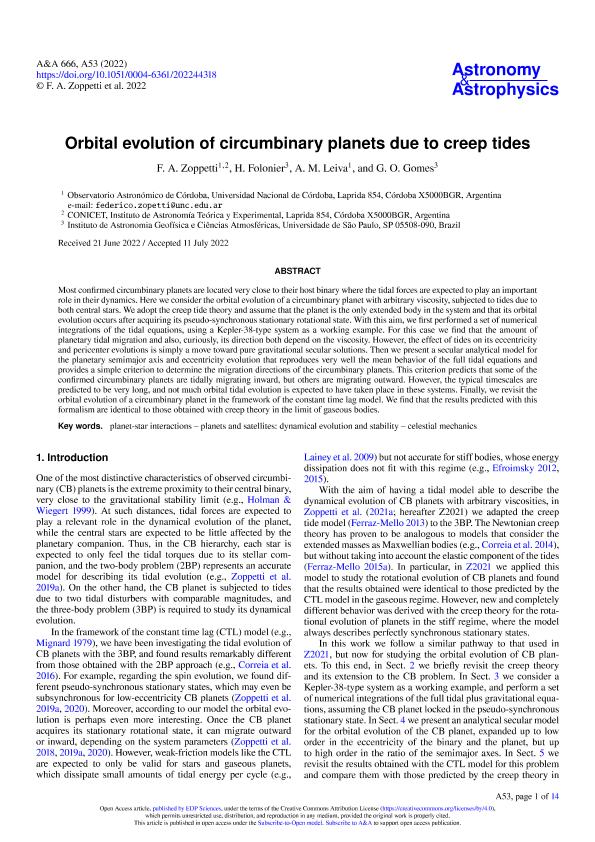Mostrar el registro sencillo del ítem
dc.contributor.author
Zoppetti, Federico Andrés

dc.contributor.author
Folonier, H.
dc.contributor.author
Leiva, Alejandro Martín

dc.contributor.author
Gomes, G.O.
dc.date.available
2023-07-10T13:23:35Z
dc.date.issued
2022-10
dc.identifier.citation
Zoppetti, Federico Andrés; Folonier, H.; Leiva, Alejandro Martín; Gomes, G.O.; Orbital evolution of circumbinary planets due to creep tides; EDP Sciences; Astronomy and Astrophysics; 666; A53; 10-2022; 1-14
dc.identifier.issn
0004-6361
dc.identifier.uri
http://hdl.handle.net/11336/202886
dc.description.abstract
Most confirmed circumbinary planets are located very close to their host binary where the tidal forces are expected to play an important role in their dynamics. Here we consider the orbital evolution of a circumbinary planet with arbitrary viscosity, subjected to tides due to both central stars. We adopt the creep tide theory and assume that the planet is the only extended body in the system and that its orbital evolution occurs after acquiring its pseudo-synchronous stationary rotational state. With this aim, we first performed a set of numerical integrations of the tidal equations, using a Kepler-38-type system as a working example. For this case we find that the amount of planetary tidal migration and also, curiously, its direction both depend on the viscosity. However, the effect of tides on its eccentricity and pericenter evolutions is simply a move toward pure gravitational secular solutions. Then we present a secular analytical model for the planetary semimajor axis and eccentricity evolution that reproduces very well the mean behavior of the full tidal equations and provides a simple criterion to determine the migration directions of the circumbinary planets. This criterion predicts that some of the confirmed circumbinary planets are tidally migrating inward, but others are migrating outward. However, the typical timescales are predicted to be very long, and not much orbital tidal evolution is expected to have taken place in these systems. Finally, we revisit the orbital evolution of a circumbinary planet in the framework of the constant time lag model. We find that the results predicted with this formalism are identical to those obtained with creep theory in the limit of gaseous bodies.
dc.format
application/pdf
dc.language.iso
eng
dc.publisher
EDP Sciences

dc.rights
info:eu-repo/semantics/openAccess
dc.rights.uri
https://creativecommons.org/licenses/by/2.5/ar/
dc.subject
CELESTIAL MECHANICS
dc.subject
PLANET-STAR INTERACTIONS
dc.subject
PLANETS AND SATELLITES: DYNAMICAL EVOLUTION AND STABILITY
dc.subject.classification
Astronomía

dc.subject.classification
Ciencias Físicas

dc.subject.classification
CIENCIAS NATURALES Y EXACTAS

dc.title
Orbital evolution of circumbinary planets due to creep tides
dc.type
info:eu-repo/semantics/article
dc.type
info:ar-repo/semantics/artículo
dc.type
info:eu-repo/semantics/publishedVersion
dc.date.updated
2023-07-06T11:21:10Z
dc.journal.volume
666
dc.journal.number
A53
dc.journal.pagination
1-14
dc.journal.pais
Francia

dc.journal.ciudad
Paris
dc.description.fil
Fil: Zoppetti, Federico Andrés. Universidad Nacional de Córdoba. Observatorio Astronómico de Córdoba; Argentina. Universidad Nacional de Córdoba. Observatorio Astronómico de Córdoba. Grupo de Invest.en Astronomia Teórica y Exptal.; Argentina
dc.description.fil
Fil: Folonier, H.. Universidade do Sao Paulo. Instituto de Astronomia, Geofísica e Ciências Atmosféricas; Brasil
dc.description.fil
Fil: Leiva, Alejandro Martín. Universidad Nacional de Córdoba. Observatorio Astronómico de Córdoba; Argentina
dc.description.fil
Fil: Gomes, G.O.. Universidade do Sao Paulo. Instituto de Astronomia, Geofísica e Ciências Atmosféricas; Brasil
dc.journal.title
Astronomy and Astrophysics

dc.relation.alternativeid
info:eu-repo/semantics/altIdentifier/url/https://www.aanda.org/articles/aa/full_html/2022/10/aa44318-22/aa44318-22.html
dc.relation.alternativeid
info:eu-repo/semantics/altIdentifier/doi/https://doi.org/10.1051/0004-6361/202244318
Archivos asociados
